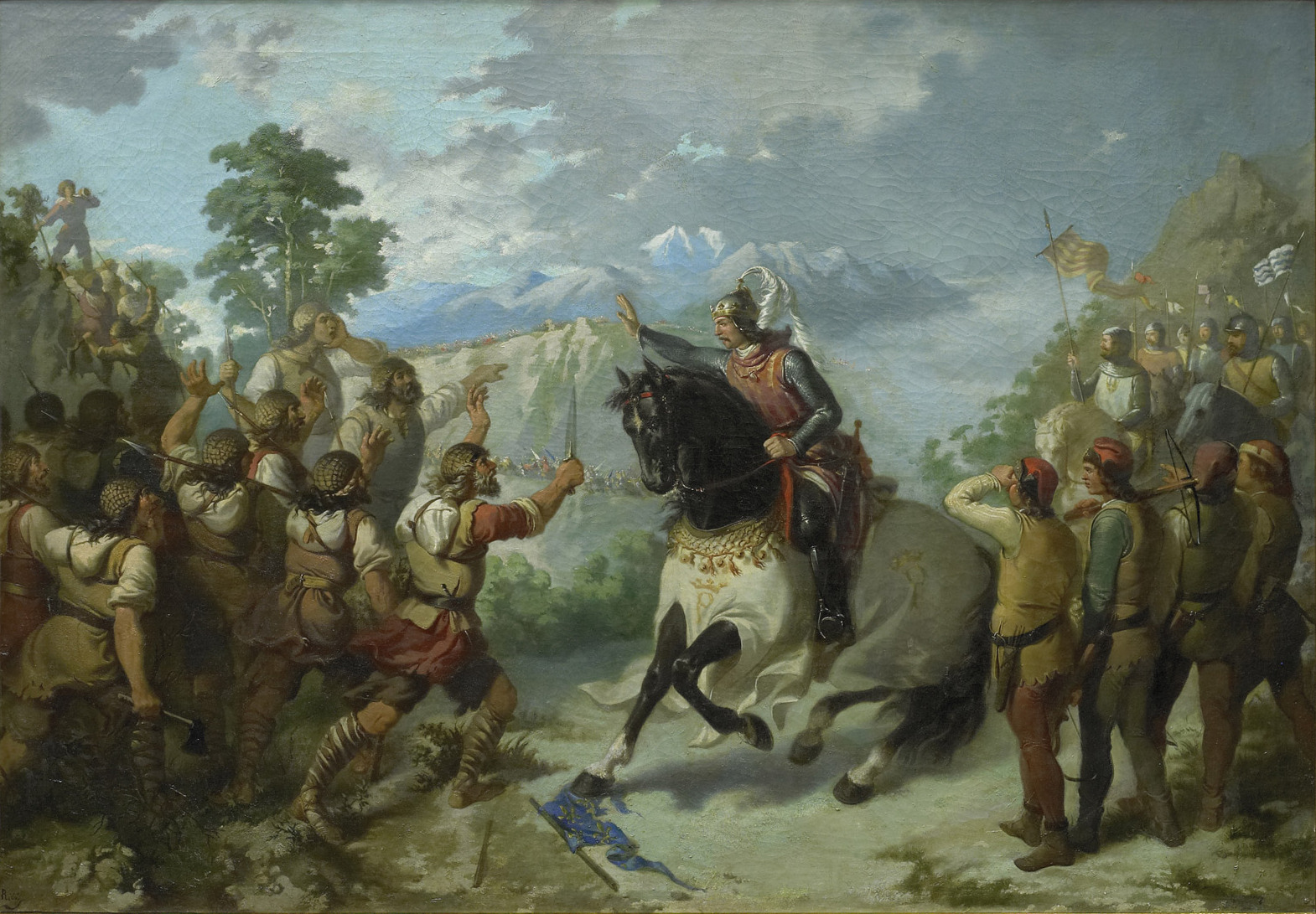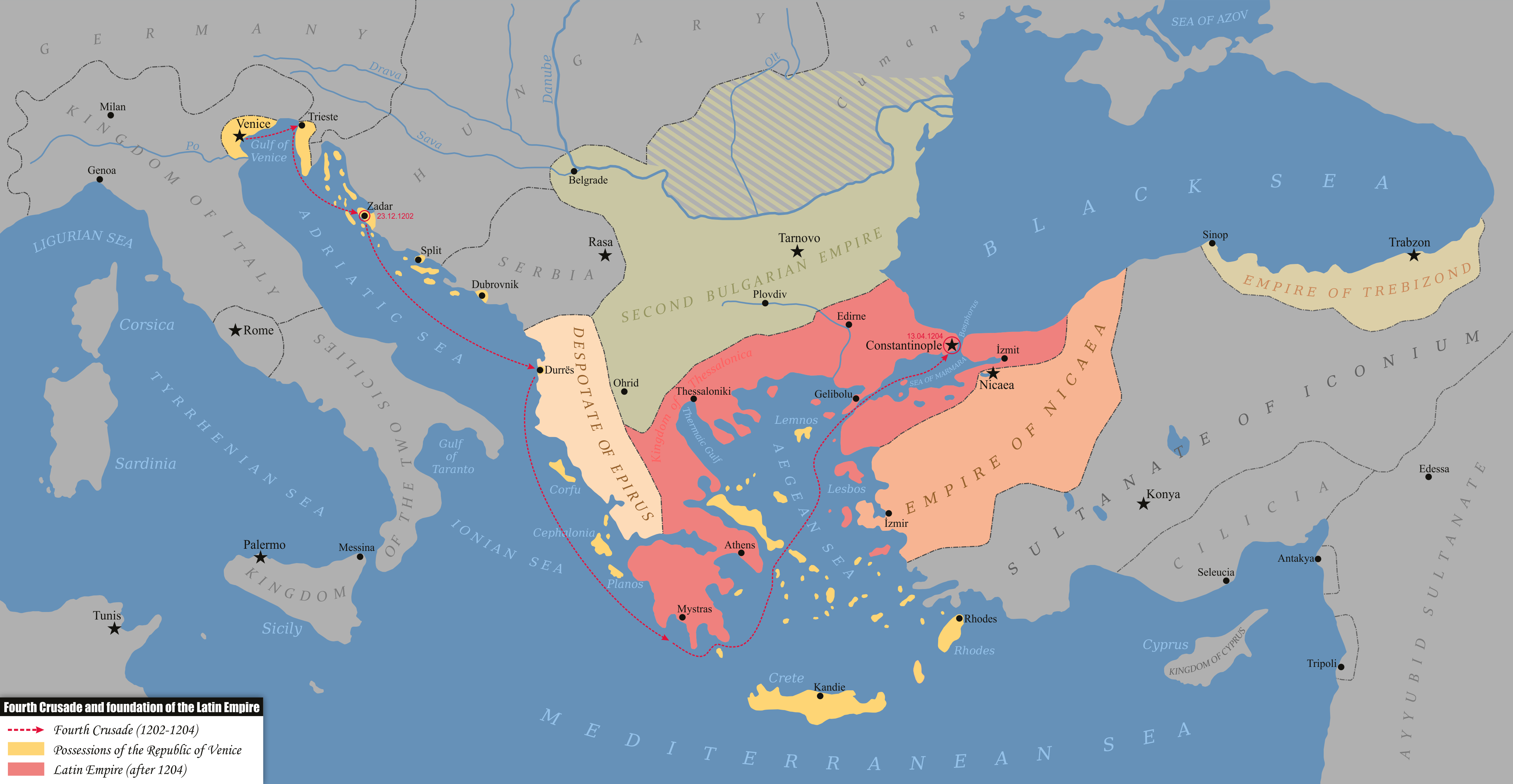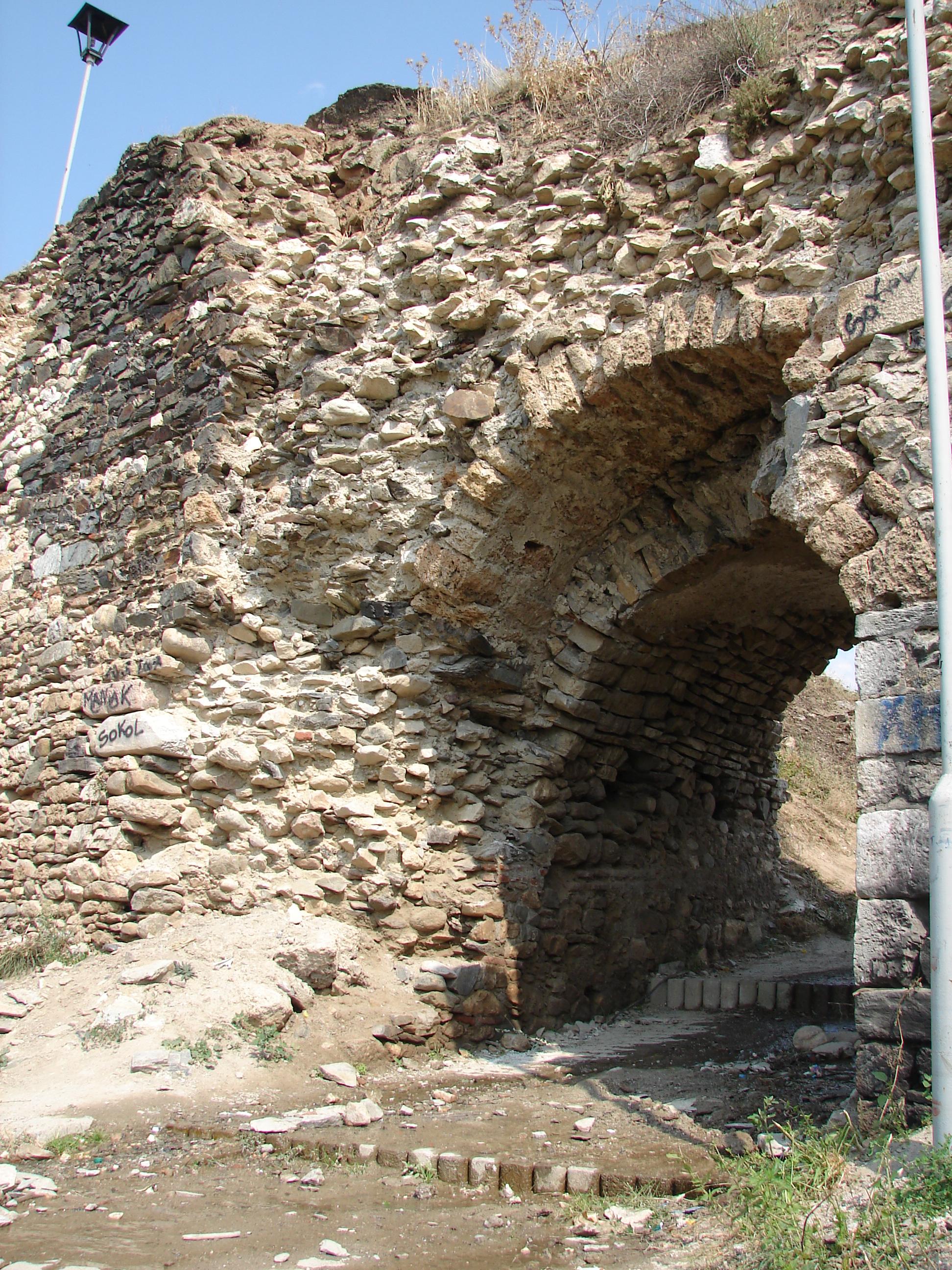|
Byzantine Army (Palaiologan Era)
The Palaiologan army refers to the military forces of the Byzantine Empire under the rule of the Palaiologos dynasty, from the late 13th century to its final collapse in the mid-15th century. The army was a direct continuation of the forces of the Empire of Nicaea, which itself was a fractured component of the formidable Komnenian army of the 12th century. Under the first Palaiologan emperor, Michael VIII, the army's role took an increasingly offensive role whilst the naval forces of the empire, weakened since the days of Andronikos I Komnenos, were boosted to include thousands of skilled sailors and some 80 ships. Due to the lack of land to support the army, the empire required the use of large numbers of mercenaries. After Andronikos II took to the throne in 1282, the army fell apart and the Byzantines suffered regular defeats at the hands of their eastern opponents, although they would continue to enjoy success against the Latin territories in Greece. By c. 1350 the Empire's i ... [...More Info...] [...Related Items...] OR: [Wikipedia] [Google] [Baidu] |
Palaiologan Period
The Byzantine Empire, officially known as the Roman Empire, was ruled by the Palaiologos dynasty in the period between 1261 and 1453, from the restoration of Byzantine rule to Constantinople by the usurper Michael VIII Palaiologos following its recapture from the Latin Empire, founded after the Fourth Crusade (1204), up to the Fall of Constantinople to the Ottoman Empire. Together with the preceding Nicaean Empire and the contemporary '' Frankokratia'', this period is known as the late Byzantine Empire. From the start, the regime faced numerous problems.Mango, p. 255 The Turks of Asia Minor had begun conducting raids and expanding into Byzantine territory in Asia Minor by 1263, just two years after the enthronement of the first Palaiologos emperor Michael VIII. Anatolia, which had formed the very heart of the shrinking empire, was systematically lost to numerous Turkic '' ghazis'', whose raids evolved into conquering expeditions inspired by Islamic zeal, the prospect of economic ... [...More Info...] [...Related Items...] OR: [Wikipedia] [Google] [Baidu] |
Catalan Company
The Catalan Company or the Great Catalan Company (; , , , or ) was a company of mercenaries led by Roger de Flor in the early 14th century and hired by Byzantine Emperor Andronikos II Palaiologos to combat the increasing power of the Anatolian beyliks. It was formed by '' almogavar'' veterans of the War of the Sicilian Vespers, who had remained unemployed after the signing in 1302 of the Peace of Caltabellotta between the Crown of Aragon and the French dynasty of the Angevins. Origin The military demands of the Reconquista stimulated the formation of the elite light infantry known as the '' almogavars'' on the Iberian peninsula during the 13th century. These troops were used quite effectively by the Crown of Aragon for other imperial ventures in the Mediterranean, particularly the War of the Sicilian Vespers. They were typically organised in companies (''societates'') of 20 to 50 men, following a chief of recognized military skill. The signing of the Peace of Caltabellotta i ... [...More Info...] [...Related Items...] OR: [Wikipedia] [Google] [Baidu] |
Battle Of Pelekanon
The Battle of Pelekanon, also known by its Latinised form Battle of Pelecanum, occurred on June 10–11, 1329 between an expeditionary force by the Byzantines led by Andronikos IIl and an Ottoman army led by Orhan I. The Byzantine army was defeated, with no further attempt made at relieving the cities in Anatolia under Ottoman siege. Background By the accession of Andronikos in 1328, the Imperial territories in Anatolia had dramatically shrunk from almost all of the west of modern Turkey forty years earlier to a few scattered outposts along the Aegean Sea and a small core province around Nicomedia within about 150 km of the capital city Constantinople. Recently the Turks, under their energetic leader Osman I, had captured the important city of Prusa (Bursa) in Bithynia. Andronikos decided to relieve the important besieged cities of Nicomedia and Nicaea, and hoped to restore the frontier to a stable position.Treadgold, p. 761. Clash and outcome Together with the Grand ... [...More Info...] [...Related Items...] OR: [Wikipedia] [Google] [Baidu] |
Siege Of Nicaea (1331)
The siege of Nicaea was the first major battle of the First Crusade, taking place from 14 May to 19 June 1097. The city was under the control of the Seljuk Turks who opted to surrender to the Byzantines in fear of the crusaders breaking into the city. The siege was followed by the Battle of Dorylaeum and the Siege of Antioch, all taking place in modern Turkey.Runciman, Steven (1969).Chapter IX. The First Crusade: Constantinople to Antioch. In Setton, Kenneth M.; Baldwin, Marshall W. (eds.). ''A History of the Crusades: I. The First Hundred Years''. Madison: The University of Wisconsin Press. pp. 288–290. Background Nicaea, located on the eastern shore of Lake Askania, had been captured from the Byzantine Empire by the Seljuk Turks in 1081, and formed the capital of the Sultanate of Rûm. In 1096, the People's Crusade, the first stage of the First Crusade, had plundered the land surrounding the city, before being destroyed by the Turks. As a result, sultan Kilij Arslan initial ... [...More Info...] [...Related Items...] OR: [Wikipedia] [Google] [Baidu] |
Battle Of Bapheus
The Battle of Bapheus occurred on 27 July 1302, between an Ottoman army under Osman I and a Byzantine army under George Mouzalon. The battle ended in a crucial Ottoman victory, cementing the Ottoman state and heralding the final capture of Byzantine Bithynia by the Ottoman Turks. Strategic context Osman I had succeeded in the leadership of his clan in c. 1281, and over the next two decades launched a series of ever-deeper raids into the Byzantine borderlands of Bithynia. By 1301, the Ottoman Turks were besieging Nicaea, the former imperial capital of the Byzantines, and pillaging the outskirts of Prusa. The Turkish raids also threatened the port city of Nicomedia with famine, as Turkish warrior bands roamed the countryside and prohibited the collection of the harvest (see Akinji). In the spring of 1302, the Co-Emperor Michael IX (r. 1294–1320) launched a campaign which reached south to Magnesia. The Turks, awed by his large army, avoided battle. Michael sought ... [...More Info...] [...Related Items...] OR: [Wikipedia] [Google] [Baidu] |
Despotate Of Epiros
The Despotate of Epirus () was one of the Greek successor states of the Byzantine Empire established in the aftermath of the Fourth Crusade in 1204 by a branch of the Angelos dynasty. It claimed to be the legitimate successor of the Byzantine Empire during the subsequent struggle for Constantinople, along with the Empire of Nicaea and the Empire of Trebizond; its rulers briefly proclaiming themselves as Emperors in 1227–1242 (during which it is most often called the Empire of Thessalonica). The term "Despotate of Epirus" is, like "Byzantine Empire" itself, a modern historiographic convention and not a name in use at the time. The Despotate was centred on the region of Epirus, encompassing also Albania and the western portion of Greek Macedonia and also included Thessaly and western Greece as far south as Nafpaktos. Through a policy of aggressive expansion under Theodore Komnenos Doukas the Despotate of Epirus also briefly came to incorporate central Macedonia, with the e ... [...More Info...] [...Related Items...] OR: [Wikipedia] [Google] [Baidu] |
Empire Of Trebizond
The Empire of Trebizond or the Trapezuntine Empire was one of the three successor rump states of the Byzantine Empire that existed during the 13th through to the 15th century. The empire consisted of the Pontus, or far northeastern corner of Anatolia, and portions of southern Crimea. The Trapezuntine Empire was formed in 1204 with the help of Queen Tamar of Georgia after the Georgian expedition in Chaldia and Paphlagonia, which was commanded by Alexios Komnenos a few weeks before the Sack of Constantinople. Alexios later declared himself emperor and established himself in Trebizond (now Trabzon in Turkey). Alexios and David Komnenos, grandsons and last male descendants of the deposed emperor Andronikos I Komnenos, pressed their claims as Roman emperors against Alexios V Doukas. While the rulers of Trebizond bore the title of emperor until the end of their state in 1461, their rivals, the Laskarids in Nikaia and the Palaiologoi in Constantinople contested their claim to t ... [...More Info...] [...Related Items...] OR: [Wikipedia] [Google] [Baidu] |
Kingdom Of Sicily
The Kingdom of Sicily (; ; ) was a state that existed in Sicily and the southern Italian peninsula, Italian Peninsula as well as, for a time, in Kingdom of Africa, Northern Africa, from its founding by Roger II of Sicily in 1130 until 1816. It was a successor state of the County of Sicily, which had been founded in 1071 during the Norman conquest of southern Italy, Norman conquest of the southern peninsula. The island was divided into Three valli of Sicily, three regions: Val di Mazara, Val Demone and Val di Noto. After a brief rule by Charles of Anjou, a revolt in 1282 known as the Sicilian Vespers threw off Capetian House of Anjou, Angevin rule in the island of Sicily. The Angevins managed to maintain control in the mainland part of the kingdom, which became a separate entity also styled ''Kingdom of Sicily'', although it is retroactively referred to as the Kingdom of Naples. Sicily (officially known as the Kingdom of Trinacria between 1282 and 1442) at the other hand, remained a ... [...More Info...] [...Related Items...] OR: [Wikipedia] [Google] [Baidu] |
Duchy Of Athens
The Duchy of Athens (Greek language, Greek: Δουκᾶτον Ἀθηνῶν, ''Doukaton Athinon''; Catalan language, Catalan: ''Ducat d'Atenes'') was one of the Crusader states set up in Greece after the conquest of the Byzantine Empire during the Fourth Crusade as part of the process known as Frankokratia, encompassing the regions of Attica and Boeotia, and surviving until its conquest by the Ottoman Empire in the 15th century. History Establishment of the Duchy The first duke of Athens (as well as of Thebes (Greece), Thebes, at first) was Otto de la Roche, a minor Duchy of Burgundy, Burgundian knight of the Fourth Crusade. Although he was known as the "Duke of Athens" from the foundation of the duchy in 1205, the title did not become official until 1260. Instead, Otto proclaimed himself "Lord of Athens" (in Latin language, Latin ''Dominus Athenarum'', in French language, French ''Sire d'Athenes''). The local Greeks called the dukes "Megas Kyris" (, "Great Lord"), from which ... [...More Info...] [...Related Items...] OR: [Wikipedia] [Google] [Baidu] |
Principality Of Achaea
The Principality of Achaea () or Principality of Morea was one of the vassal states of the Latin Empire, which replaced the Byzantine Empire after the capture of Constantinople during the Fourth Crusade. It became a vassal of the Kingdom of Thessalonica, along with the Duchy of Athens, until Thessalonica was captured by Despotate of Epirus, Epirus in 1224. After this, Achaea became the dominant power in Greece, lasting continuously for 227 years and cumulatively for 229. Foundation Achaea was founded in 1205 by William of Champlitte and Geoffrey I of Villehardouin, who undertook to conquer the Peloponnese on behalf of Boniface I, Marquis of Montferrat, Boniface of Montferrat, Kingdom of Thessalonica, King of Thessalonica. With a force of no more than 100 knights and 500 foot soldiers, they took Achaea and Medieval Elis, Elis, and after defeating the local Greeks in the Battle of the Olive Grove of Koundouros, they became masters of the Morea. The victory was decisive, and after t ... [...More Info...] [...Related Items...] OR: [Wikipedia] [Google] [Baidu] |
Second Bulgarian Empire
The Second Bulgarian Empire (; ) was a medieval Bulgarians, Bulgarian state that existed between 1185 and 1422. A successor to the First Bulgarian Empire, it reached the peak of its power under Tsars Kaloyan of Bulgaria, Kaloyan and Ivan Asen II before gradually being conquered by the Ottoman Empire, Ottomans in the late 14th century. Until 1256, the Second Bulgarian Empire was the dominant power in the Balkans, defeating the Byzantine Empire in several major battles. In 1205, Emperor Kaloyan of Bulgaria, Kaloyan defeated the newly established Latin Empire in the battle of Adrianople (1205), Battle of Adrianople. His nephew Ivan Asen II defeated the Despotate of Epiros and made Bulgaria a regional power again. During his reign, Bulgaria spread from the Adriatic Sea, Adriatic to the Black Sea and the economy flourished. In the late 13th century, however, the Empire declined under constant invasions by Mongols, Byzantine Empire, Byzantines, Hungarians, and Serbia in the Middle Ages ... [...More Info...] [...Related Items...] OR: [Wikipedia] [Google] [Baidu] |
Serbian Empire
The Serbian Empire ( sr-Cyrl-Latn, Српско царство, Srpsko carstvo, separator=" / ", ) was a medieval Serbian state that emerged from the Kingdom of Serbia. It was established in 1346 by Dušan the Mighty, who significantly expanded the state. During Dušan's rule, Serbia was one of the most powerful European states and, the most powerful in Southeast Europe. It was an Eastern Orthodox multi-ethnic and multi-lingual empire that stretched from the Danube in the north to the Gulf of Corinth in the south, with its capital in Skopje. Dušan also promoted the Serbian Archbishopric to the Serbian Patriarchate. In the Serbian Empire, the region of Kosovo was the most prosperous and densely populated area, serving as a key political, religious, and cultural center. Dušan's son and successor, Uroš the Weak, struggled to maintain his father's vast empire, gradually losing much of the conquered territory - hence his epithet. The Serbian Empire effectively ended wit ... [...More Info...] [...Related Items...] OR: [Wikipedia] [Google] [Baidu] |







